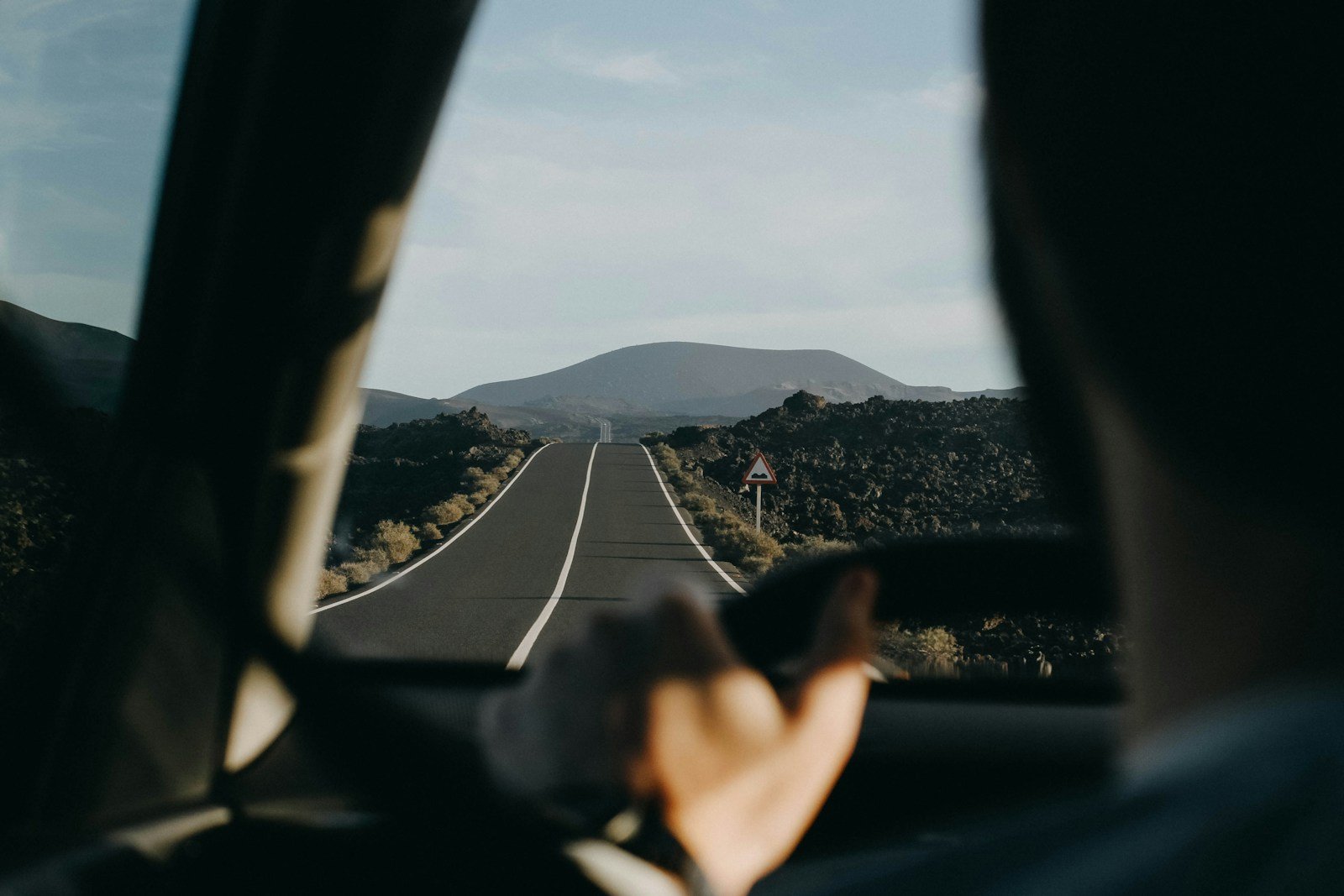Looking for the best things to see in Lanzarote by car? Renting a car is hands down the easiest way to experience the island’s more remote places. From volcanic craters and cliffside viewpoints to sleepy villages and coastal photo spots, some of Lanzarote’s best sights are scattered far from resort zones and tour bus routes.
This guide takes you through 17 must-see stops and driving routes on your Lanzarote holidays. It’s a mix of quick photo opportunities, longer drives, and scenic spots that link them all together. Whether you’re planning a half-day road trip or a full week of exploration around the island, here’s exactly what to see and do in Lanzarote if you’re seeing it by car.
- Mirador del Río
- Timanfaya National Park
- El Golfo & the Green Lagoon
- Los Hervideros
- Salinas de Janubio
- Playa de Papagayo
- Montaña Roja
- La Geria Wine Region
- Haría & the Mirador de Haría
- Teguise Old Town
- César Manrique Foundation
- Las Grietas
- Playa Quemada
- Monumento al Campesino
- Charco de San Ginés
- Peñas del Chache
- Arrieta & Punta Mujeres
Mirador del Río
Mirador del Río sits at the very top of the Risco de Famara cliffs, giving you panoramic views over the Chinijo Archipelago and the island of La Graciosa. Designed by César Manrique, the viewpoint is cleverly built into the cliff face, so you barely see it from the outside. Inside, curved windows frame the view like a widescreen cinema, and there’s a small café where you can relax while looking out across the Atlantic.
The drive up is just as impressive as the destination. If you’re coming from Haría, the winding hairpin road climbs through green valleys and pine-covered hills before reaching the coast. It’s one of the most scenic inland drives on the island and feels far removed from the dry, flat south.
If you’re planning to visit La Graciosa, this viewpoint offers the perfect preview. You can also link this stop with Haría and Teguise to form a rewarding loop for anyone looking for scenic spots with a romantic atmosphere.
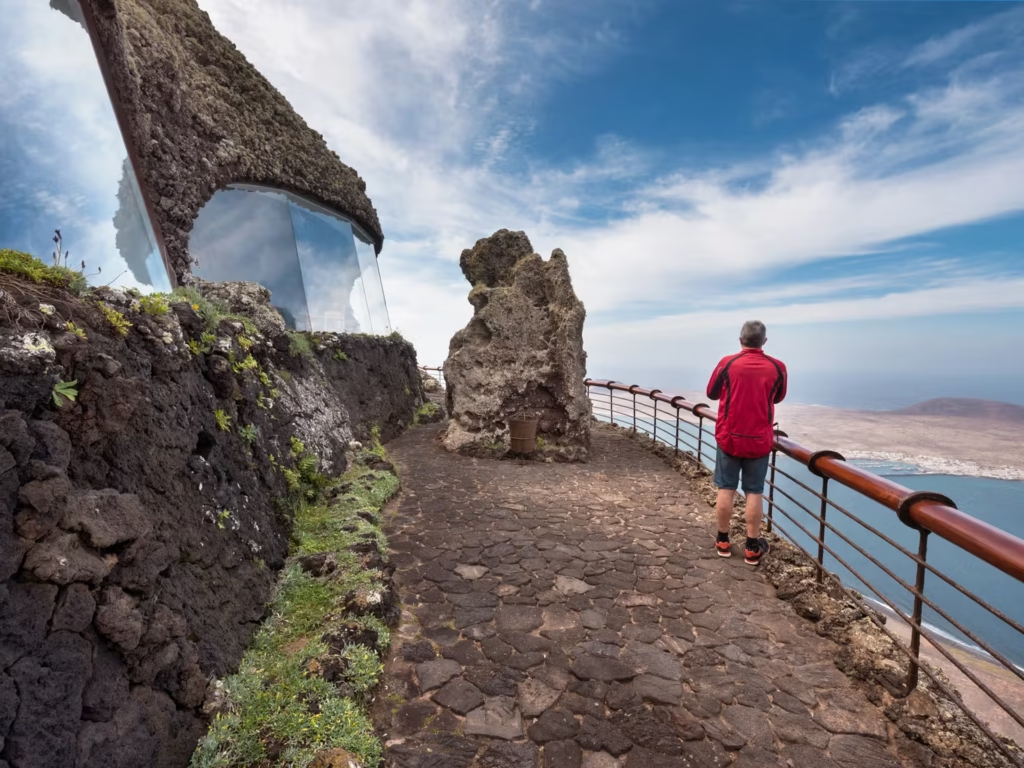
Timanfaya National Park
If you’re seeing Lanzarote by car, Timanfaya National Park should be near the top of your list. While you can’t drive through the volcanic core on your own, your entry ticket includes access to a guided coach tour along the Ruta de los Volcanes. It’s a one-of-a-kind route that passes through lava fields, dormant craters, and steaming vents. It’s as close to driving on the moon as you’ll get in Europe.
Getting there by car is simple, with clear signage from Yaiza or Tinajo. You’ll park at Islote de Hilario, where the tours begin and geothermal demonstrations take place. Staff ignite dry brush using natural heat and turn water into steam jets.
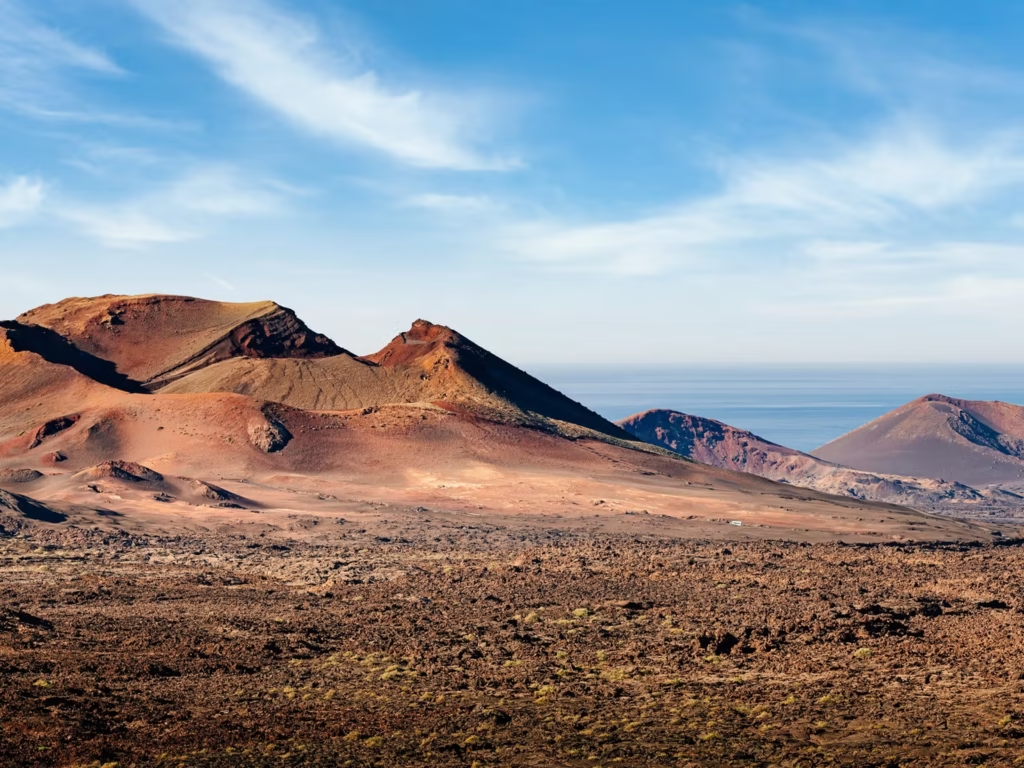
El Golfo & the Green Lagoon
Driving along the southwest coast brings you to the tiny fishing village of El Golfo, home to the famous Charco de los Clicos, or the Green Lagoon. This emerald-coloured pool, formed inside a half-collapsed volcanic crater, sits right next to black sand beaches and rust-red cliffs, creating one of Lanzarote’s most visually striking photo stops.
Park in the main lot and walk five minutes to the elevated viewpoint for the best angle. If you have time, head down to the beach itself, which is usually quiet and peaceful in the morning. The town has a handful of casual seafood restaurants, perfect for lunch after sightseeing.
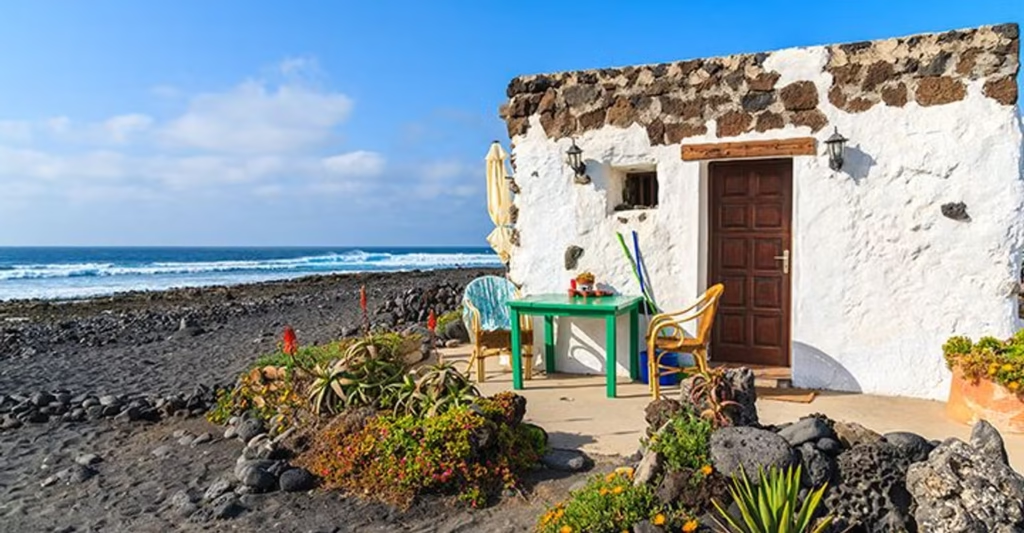
Los Hervideros
Just a 10-minute drive south from El Golfo, Los Hervideros offers a dramatic encounter between land and sea. This stretch of rugged coastline is where ancient lava met the Atlantic, forming cliffs and blowholes that channel the power of the waves. The name “Los Hervideros” translates to “the boiling pots”, and when the tide is high, you’ll see exactly why.
There’s a free car park, and a short walking path leads along the clifftops and down into viewing platforms carved into the volcanic rock. You don’t need more than 30 minutes here, but it’s one of the most photogenic stops on the island, especially in late afternoon light.
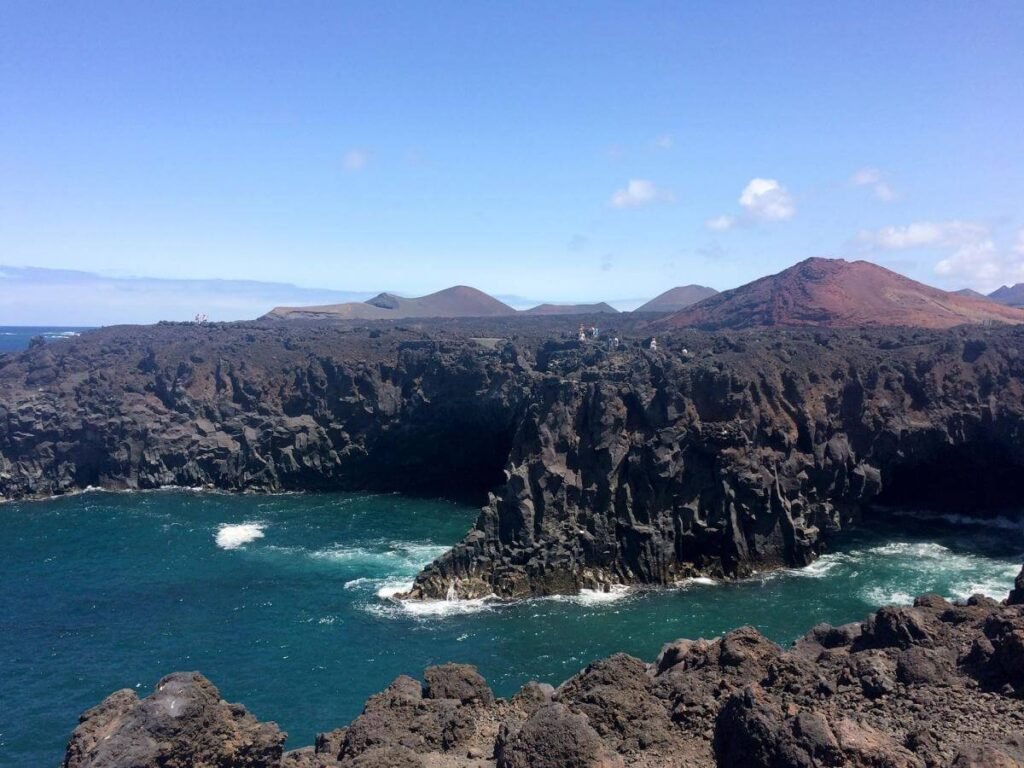
Salinas de Janubio
Continue five minutes from Los Hervideros and you’ll reach the Salinas de Janubio, Lanzarote’s largest and oldest salt flats. Once an economic lifeline for the island, the site is still partly operational today, producing artisanal sea salt. The salt pans stretch across a wide, shallow basin, and their colours shift throughout the day, from white to pink to rust-red, depending on mineral content and sunlight.
There’s a small visitor centre and guided tours are available, but you can also enjoy the view from the roadside lookout if you’re short on time. Photographers should come close to sunset for the best reflections and lighting.
Playa de Papagayo
Papagayo’s network of golden-sand coves lies inside the Los Ajaches Natural Monument, and while it’s a popular spot, it’s also one of the most rewarding beaches to reach by car. From Playa Blanca, follow signs toward the Papagayo entrance (you’ll pay a €3 access fee), then drive 10–15 minutes along a bumpy dirt track. Low cars can manage the route slowly.
You’ll reach a series of small beaches including Playa Mujeres and the iconic Playa de Papagayo. Calm, clear waters and a remote feel make it one of Lanzarote’s most romantic and photogenic coastal areas. There’s a cliffside bar for drinks, but no shops, so come prepared.

Montaña Roja
Located just outside Playa Blanca, Montaña Roja is a wide volcanic cone that’s surprisingly easy to summit. Drive to the residential streets at its base (Calle España or Calle Austria have public parking) and follow the dirt trail that spirals to the top in 30–45 minutes. It’s a manageable hike even for casual walkers, and the reward is a 360° view of the southern coastline, Playa Blanca, and on clear days, Fuerteventura.
Sunrise and late afternoon are the best times to go, not just for the view, but for cooler temperatures. There’s no shade and no signage, so bring water and sun protection.
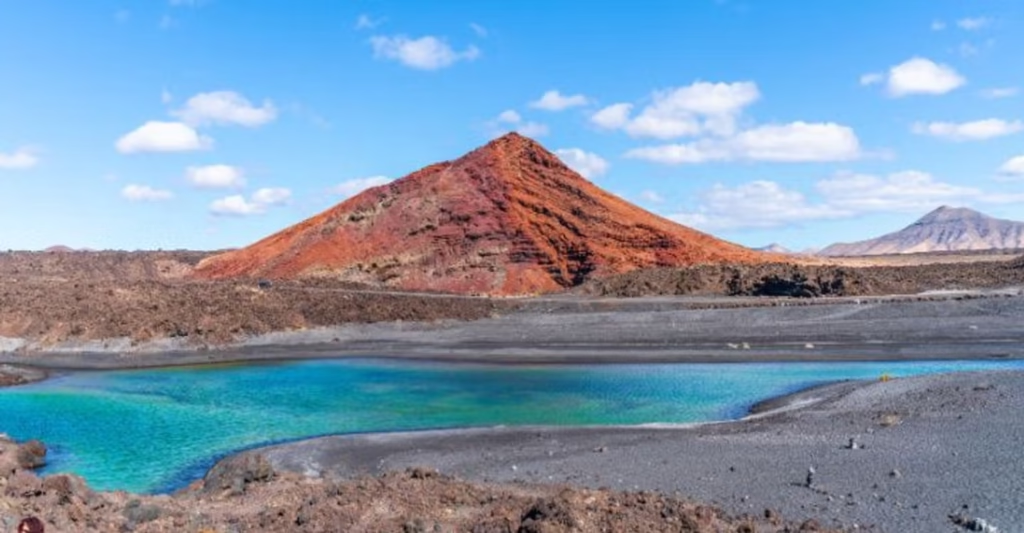
La Geria Wine Region
Driving through La Geria is one of the most uniquely Lanzarote experiences you can have. Black volcanic ash carpets the land, with each vine hand-planted in its own sunken pit and protected by stone semicircles known as zocos. The result is a surreal, patterned landscape that looks unlike any other wine region in Europe.
The road (LZ-30) cuts right through the valley, linking Uga and Teguise, and is dotted with family-run wineries such as Bodegas Rubicón, El Grifo, and La Geria itself. Many offer free tastings or low-cost sample menus, which are perfect for a mid-route break. Some wineries also make picnic packs, so you can stop and take in the views with a glass in hand.

Haría & the Mirador de Haría
As you drive north toward Haría, the landscape shifts dramatically. Palm-filled valleys replace lava fields, and narrow winding roads give way to quiet mountain viewpoints. Known as the “Valley of 1,000 Palms,” Haría is one of Lanzarote’s most picturesque villages, which is perfect for a short stop or lunch break.
Just before reaching the town, pull into the Mirador de Haría (also known locally as El Bosquecillo), a free viewpoint that offers sweeping views over the valley and north coast. The drive itself is part of the experience, especially if you’re coming up from Teguise on the hairpin-filled LZ-10.
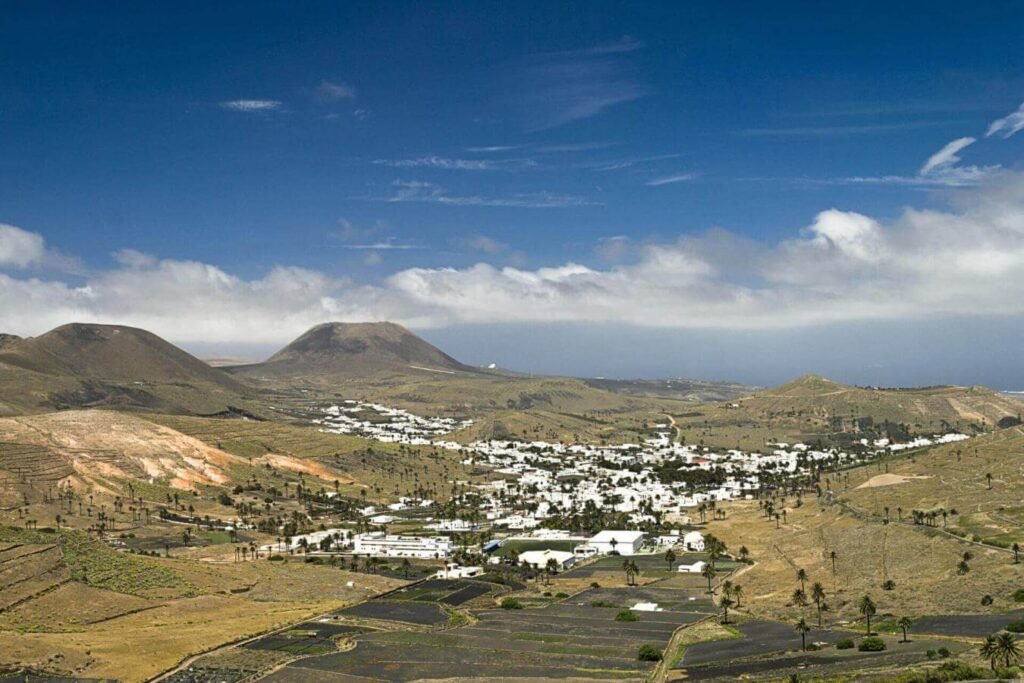
Teguise Old Town
Teguise, Lanzarote’s former capital, is one of the best-preserved historical areas on the island. It’s a pedestrian-friendly town with whitewashed buildings, cobbled lanes, and small plazas filled with local life. Free to visit and easy to explore, it’s well worth a short detour by car, particularly if you’re pairing it with La Geria, Haría, or the César Manrique Foundation.
There are small museums, quiet churches, and local cafés that serve traditional Lanzarote dishes and pastries. On Sundays, the town transforms into the island’s largest street market. It becomes a lively event full of live music, crafts, and food stalls.

César Manrique Foundation
Just outside Teguise near the village of Tahiche, the César Manrique Foundation is one of Lanzarote’s most iconic stops, and a great mid-route experience if you’re circling the island by car. Built into a series of volcanic bubbles, this former home of the artist seamlessly blends architecture with natural rock formations.
You’ll explore underground rooms connected by lava tunnels, sunken lounges, and open courtyards that showcase Manrique’s philosophy of harmony between nature and design. The space also displays his artworks and sketches, alongside pieces by Picasso and Miró.
Las Grietas
Las Grietas (“the cracks”) is one of Lanzarote’s most photographed, but still surprisingly under-visited, natural formations. Located just off the LZ-35 road near Montaña Blanca, this narrow fissure in the volcanic rock was formed by seismic activity and erosion over thousands of years. You can park along the roadside and walk a short path into the crevice itself.
Once inside, you’ll find yourself surrounded by twisting rock walls with light filtering through from above. The space is narrow but not difficult to navigate, though it’s best visited in the early morning before crowds arrive. Wear closed shoes and be cautious of loose stones.
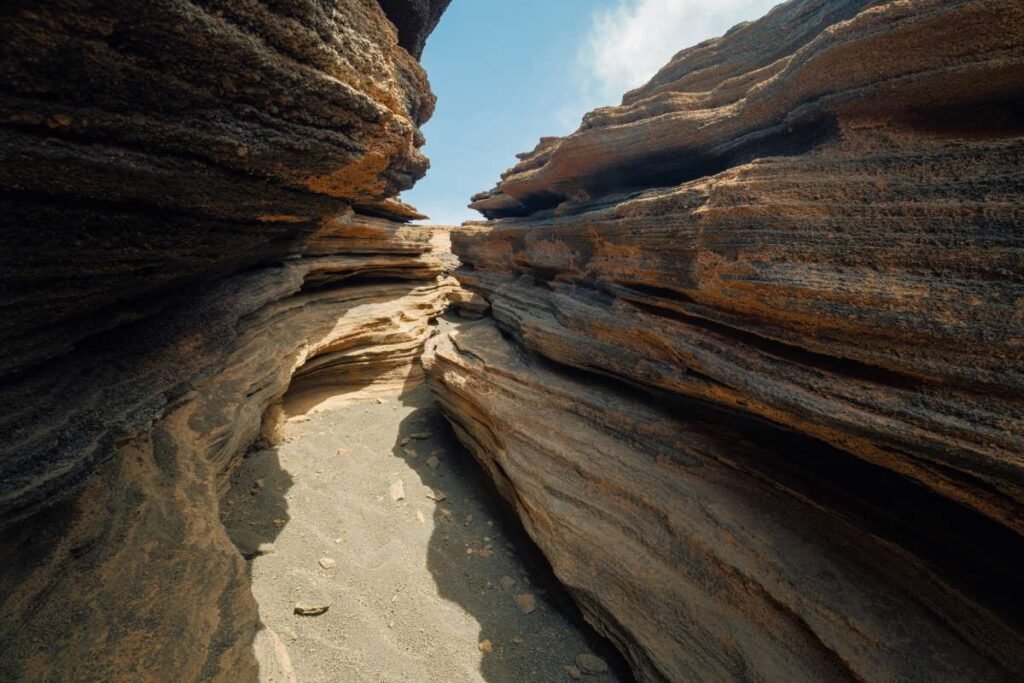
Playa Quemada
Just a 10-minute drive from Puerto Calero, Playa Quemada is a sleepy fishing village with dark volcanic sands and uninterrupted views across the water to the cliffs of Femés. Unlike resort beaches, this area feels rustic and authentic. A short walk along the shore brings you to small seafood restaurants serving fresh grilled fish, octopus, and local potatoes.
It’s a great lunch stop if you’re looping the south coast or heading inland toward the mountains. There are no sun loungers or tourist services here, just fishing boats, pebble beaches, and quiet charm.
It makes visiting this place quite a unique experience, as it offers a look at local life away from the more curated parts of the island.
Monumento al Campesino
In the centre of the island at Mozaga, just off the LZ-20, you’ll find Monumento al Campesino, an abstract white sculpture rising from a wide plaza, created by César Manrique and sculptor Jesús Soto. It honours the island’s rural workers and sits beside a beautifully restored traditional farmhouse that now serves as a cultural centre and restaurant.
There’s a free car park on site and no charge to explore the monument or surrounding complex. You can walk through exhibits on Lanzarote’s agricultural past, watch live craft demonstrations (like pottery and weaving), and browse a small artisan shop.
This is an ideal stop if you’re looking for things to see in Lanzarote by car on a central loop that connects La Geria, Teguise, and San Bartolomé. It also offers a nice cultural balance to the island’s volcanic and beach-heavy highlights.
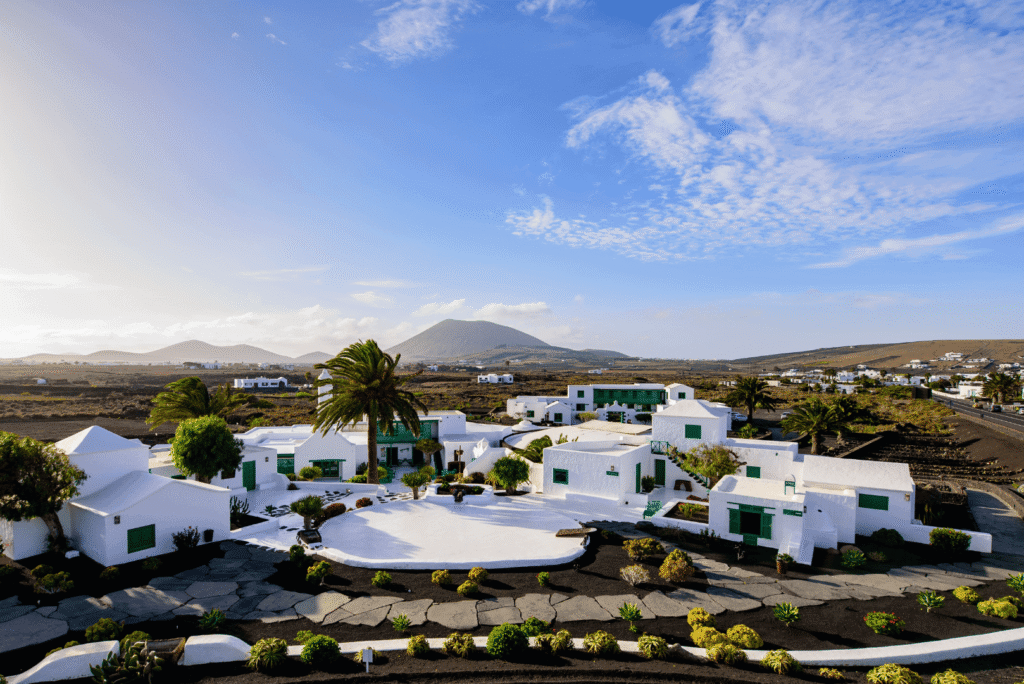
Charco de San Ginés
If you’re passing through Arrecife, don’t miss Charco de San Ginés, a natural saltwater lagoon right in the heart of the city. The lagoon is lined with colourful boats, palm trees, and a pedestrian promenade filled with cafés, bars, and tapas spots. You can park in the nearby streets or the large car park behind Calle León y Castillo.
It’s a peaceful place to pause during a longer drive or end your day with a waterside meal. Visit in the evening to see the area lit up by streetlamps and soft reflections from the water. The vibe is far more local than touristy.
Peñas del Chache
Peñas del Chache sits at 671 metres above sea level, making it the highest accessible point in Lanzarote. Located just above Haría, this viewpoint offers dramatic views across the northern coast and out towards the Chinijo Archipelago. While there’s a military installation at the summit (off-limits), the surrounding area is open and offers plenty of pull-ins for photos or a quiet picnic.
You can reach it via the LZ-10, either from Haría or Teguise. The drive is steep and winding but well worth it for the scenery and solitude.

Arrieta & Punta Mujeres
As you loop back along Lanzarote’s northeast coast, the villages of Arrieta and Punta Mujeres offer a final stop packed with character. Arrieta is a traditional fishing town with a long, sandy beach (Playa de La Garita) and some excellent seafood spots. Punta Mujeres, just five minutes north, is best known for its free natural sea pools built into the volcanic rock. They are safe, calm, and popular with locals.
Both towns are easy to park in, and they feel refreshingly non-commercial. You’ll also find aloe vera farms and artisan producers nearby, ideal if you’re looking to finish your drive with something more relaxed and rooted in local life.
